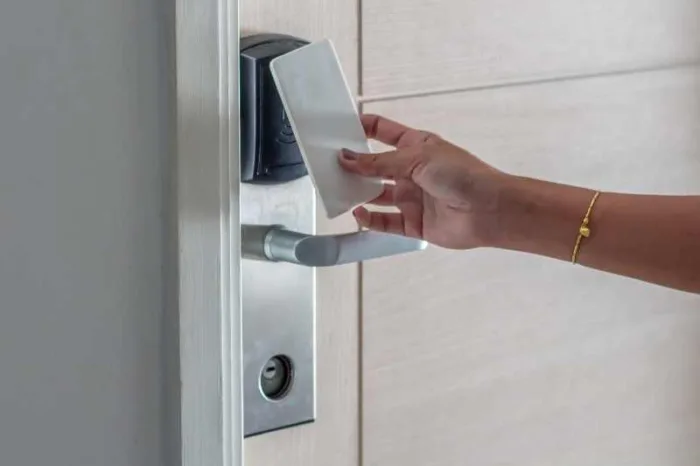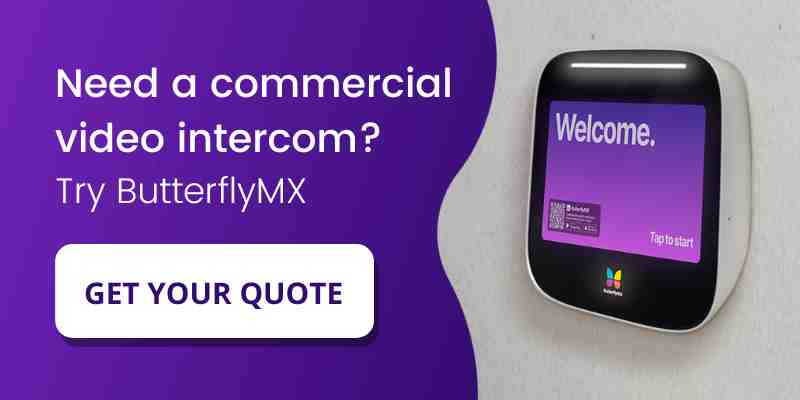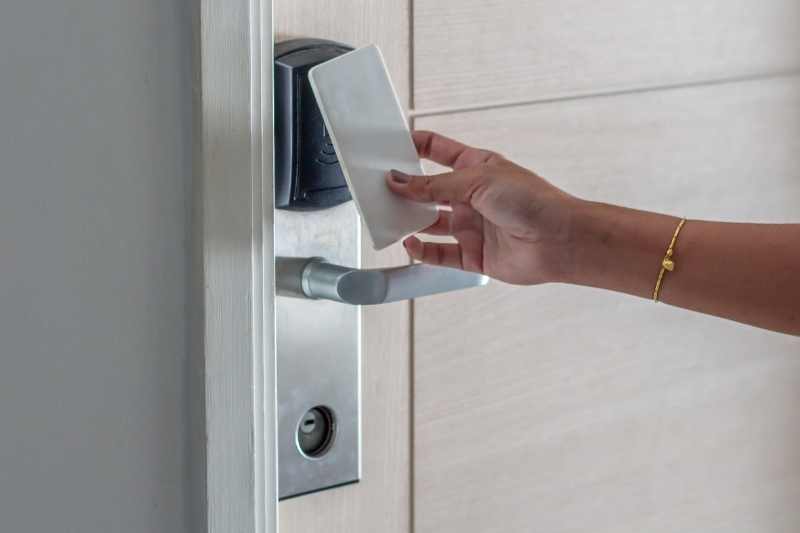
If you own or manage a property, you know how important it is to physically secure the building. After all, you want to ensure top-notch security without compromising on convenience. Finding the best door locksets for your property will go miles in helping you provide these things. One popular solution you might turn to is a commercial key card door lock system.
This complete guide covers what key card door locks are, their components, and how they work. Next, we take you through the advantages and disadvantages of commercial key card locks. Finally, we offer an alternative, more robust access control solution.
This guide covers:
- What is a key card door lock?
- How do key card door locks work?
- Key card door locks pros and cons
- The best alternative to key card door locks
What is a key card door lock?
A key card door lock is a type of electronic lock that tenants can open using a key card credential. Because they’ve been around for decades, key card locks are a popular keyless entry solution for commercial and multifamily buildings.
In fact, you’ve likely seen them before! They often come in the form of plastic cards — and even ID badges can act as key cards with the correct technology.

Key card locks differ slightly from commercial keypad door locks. While the use cases of both are almost identical — custodial closets, office amenity spaces, parking garages, and rooms with restricted access areas — the credential differs.
While each tenant may have a unique PIN code, keypads can also have one PIN code that everyone uses. Conversely, commercial key card door locks require each person to have their own keycard.
Moreover, key card door locks are functionally identical to key fob door lock systems! The only difference is that tenants use a key card as a credential instead of a key fob. This means that when deciding between these two, the keyless door lock system you choose comes down to the functionality of the credential.
For example:
Do you want to offer tenants an access credential that can fit in their wallet or pocket? Or one that needs to be stored on a key ring?
Check out how the ButterflyMX keypad works:
Components of key card door locks:
- Key card. The key card replaces a brass key in this keyless entry solution. Instead, tenants hold their key cards up to the card reader to gain access.
- Card reader for doors. The reader identifies the key card and sends a signal to the electronic key card door lock to release it if the correct credentials are provided.
- Electronic card door lock. The electronic key card door lock automatically opens when proper key card credentials are scanned. Once tenants close the door behind them, the keyless lock returns the door to the locked position.
How do key card door locks work?
A commercial key card door lock works by establishing a connection between a user’s key card and the reader through RFID (radio frequency identification) technology. When the correct key card credentials are scanned, the reader signals the door lock to release, allowing the user to enter.
Before distributing key cards, your building staff programs each key card to unlock the specific door(s) a tenant is authorized to open.
Pro-tip: If a tenant moves out, is evicted, or simply loses their key, building administrators can simply deactivate the key. This way, you never have to worry about key cards falling into the wrong hands!
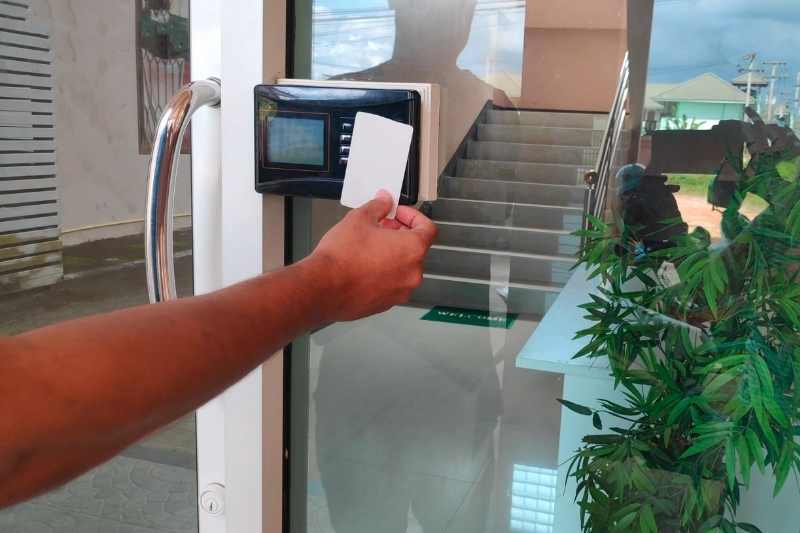
Opening a door with a key card lock is as easy as 1-2-3!
- Tenant holds the key card up to the door lock. Typically, key card readers require the card to be within 1-2 inches from it. However, some RFID technology requires tenants to physically place the key card on the reader.
- Reader verifies the key card. The reader compares the key card credentials to its database. Once it verifies that the card is a match, the reader signals the door to open.
- The keyless door lock opens. The door will remain unlocked for a set amount of time, allowing the tenant to enter. After the door is closed, the lock will automatically return to the locked position for optimal security.
Key card door locks pros & cons
Many commercial property owners and managers consider key card door locks as an alternative to traditional lock-and-key systems. But before you purchase a key card door lock system for your property, consider its pros and cons.
Pros:
- Simple installation. Electronic door locks are easy to install because they don’t involve wiring. Additionally, key cards can be easily deactivated in the event they’re stolen.
- User friendly. Simply swiping or tapping a card is much easier than fumbling around with a key. Even your most technologically-resistant tenants will welcome the switch from brass keys to key cards.
- Convenient. The card itself is small and fits into most pockets and wallets, eliminating the need for a key ring.
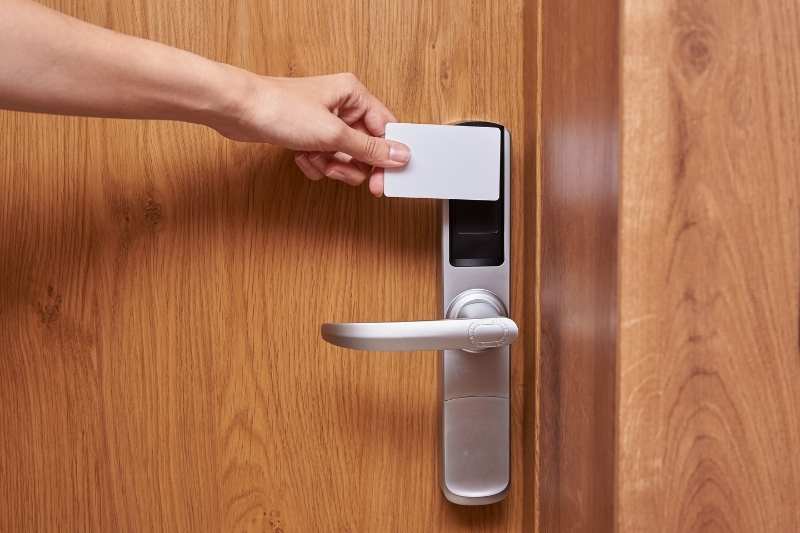
Cons:
- Easily lost or stolen. Similar to traditional keys, key cards can be easily misplaced or stolen. But unlike traditional keys, they’re expensive to replace since they require programming on special equipment. So, if a key card is lost, you’ll have to spend extra time (and money) replacing the credential.
- Susceptible to security breaches. Unfortunately, key cards can be hacked. While property staff can deactivate key cards at any time, hackers can easily duplicate key cards with machines available for as little as $10. This greatly increases the risk of security breaches for your property and tenants.
- Easily damaged. Key cards are very easily damaged. And once the magnetic strip is damaged, your tenant’s key card must be replaced.
Overall, key card door locks are slightly more convenient than traditional lock-and-key systems. That said, the convenience of swiping a card instead of using a key may not be worth replacing your entire lock.
Luckily, there’s a more robust door entry system you can consider as an alternative.
The best alternative to key card door locks
Key card door locks are a popular door entry system. But they lack the convenience and security of modern access control systems.
Don’t worry:
There are more tech-savvy electronic door lock access control solutions available. The best alternative to a commercial key card door lock is a device like the ButterflyMX keypad.
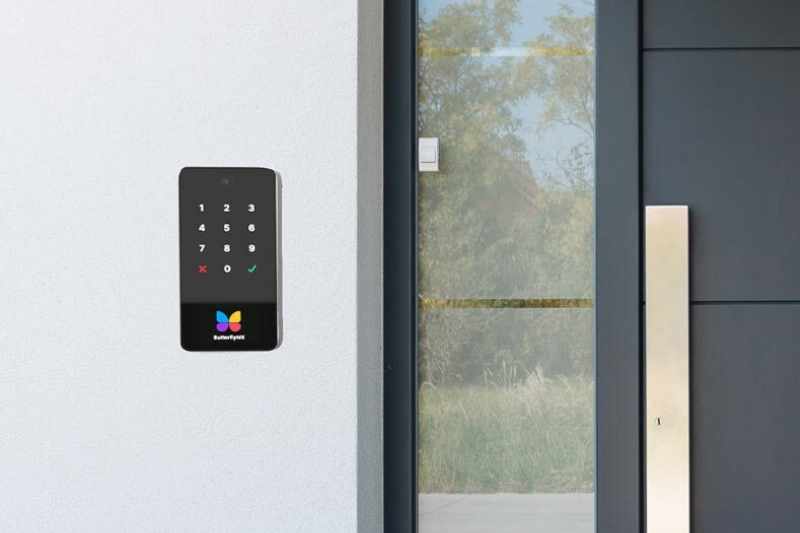
With the ButterflyMX keypad, you get:
- Remote guest access. Tenants can grant access to visitors and delivery couriers from anywhere in the world by granting temporary access PIN codes.
- Easy installation. The ButterflyMX keypad is easy to install at any entry point in your building. What’s more, software updates install automatically over the internet. This greatly reduces the need for maintenance.
- Smartphone connectivity. In addition to PIN codes, tenants can enter simply by swiping their phone screens — just have them download the smartphone app.
- Security camera. For added security, the camera snaps a date- and time-stamped photo of every person who uses the keypad. These photos from the keypad are stored in the cloud, ensuring both building and tenant security.
- Easy property management. With the ButterflyMX keypad, there’s no need to distribute key cards! In fact, all access permission settings are done remotely through the cloud-based dashboard. This saves you time and money managing and replacing key cards.
Takeaways
- Key card door locks are often installed at commercial properties. In fact, they’ve been the go-to choice for commercial buildings for several decades.
- However, key card door locks don’t provide the robust security necessary for modern businesses, as they’re easily hacked or stolen.
- Instead, consider investing in a keypad system with smartphone connectivity, a camera, and cloud-based audit trails.
- The ButterflyMX keypad accommodates tenants and guests — increasing convenience without compromising security.
